Types of Black and Yellow Wasps (With Pictures) – Identification Guide
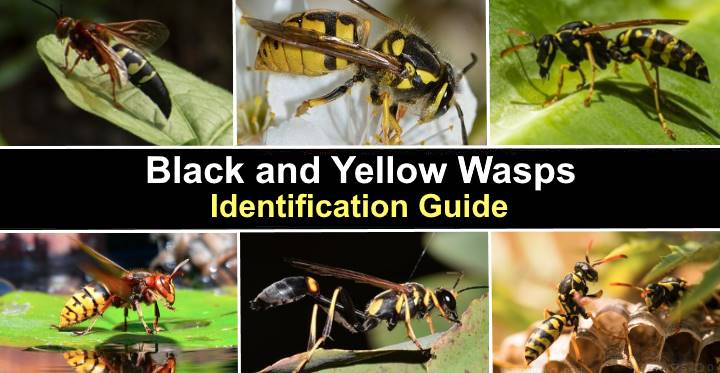
Black and yellow wasps are the most common types of wasps you are likely to find. These black and yellow-banded flying insects are easy to tell apart from most bees. Black and yellow wasps have slender, hairless bodies, a pair of transparent wings, and six legs. Wasps also have a characteristic slender waist between their abdomen and thorax.
It is vital to identify species of black and yellow wasps. Common wasps like yellowjackets (Vespula alascensis) can cause a painful sting and attack without provocation. Also, black and yellow hornets (Vespa crabro) can swarm when protecting nests, and multiple stings can have painful consequences. However, black and yellow paper wasps (Polistinae spp.) rarely sting humans.
This article is a black and yellow wasp identification guide. Descriptions and pictures of common wasp species with black and yellow bodies will help recognize these annoying insects as they buzz around your garden.
The Most Common Black and Yellow Wasps
Yellowjackets are the most common types of black and yellow wasps you will likely find in your yard. The black and yellow striped flying insects are easy to mistake for bees. Several species of yellowjackets are native to North America. These include the common yellowjacket (Vespula alascensis), western yellowjacket (Vespula pensylvanica), and prairie yellowjacket (Vespula atropilosa).
How to Identify Black and Yellow Wasps
To identify black and yellow wasp species, look at the color of their head, thorax, abdomen, and overall size. Depending on the species, the black and yellow stripes can be broader or larger. Also, take note of the wasp’s size, anchor-shaped back, and any particular markings.
Black and yellow wasps have a distinctive appearance that makes them easy to spot compared to bees. For example, the yellow-striped black insects have an easily recognizable thin waist and a hairless body. Additionally, they tend to have an aggressive flight pattern — hovering back and forth, ready to attack.
Wasps vs. Hornets
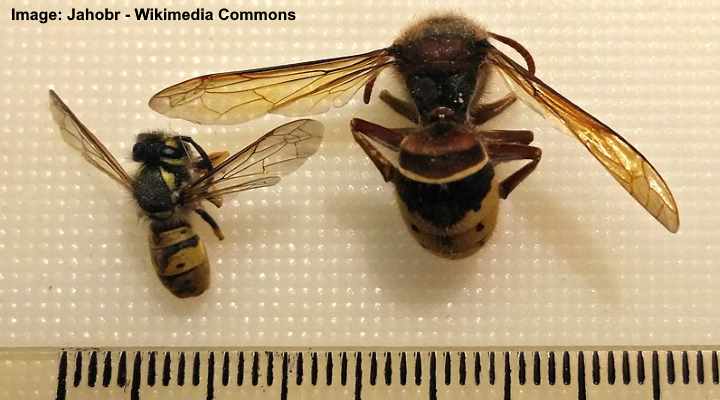
Size comparison of wasp (left) and hornet (right)
Wasps and hornets belong to the same family Vespidae. The primary differences between hornets and wasps are their size and behavior. True hornets are the largest species of wasps and have a more potent sting than wasps. Although hornets have a reputation for aggressiveness, wasps tend to be the more aggressive species.
It’s easy to tell hornets and wasps apart by their size. Although hornets are related to yellowjackets, they are much larger. For example, the black and yellow European hornet measures between 1” and 1.4” (25 – 35 mm). However, yellowjackets are smaller, measuring around 0.47” (12 mm) long.
Black and Yellow Wasps (With Pictures) — Identification Guide
Do you want to identify species of black and yellow wasps? If so, please continue reading. You will find helpful identification in this guide to black and yellow wasps.
Common Yellowjacket (Vespula alascensis)
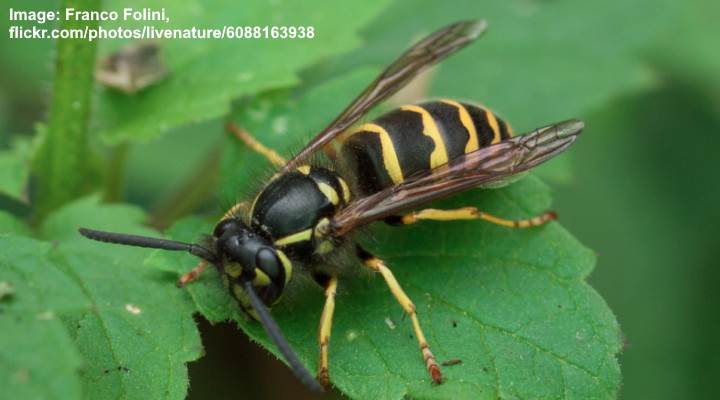
The common yellowjacket is identified by its smooth black and yellow striped body and brown transparent wings
Also called the North American yellowjacket, this common black and yellow wasp is a ground-nesting insect. The common yellowjacket is identified by its transparent brown wings, black body with yellow stripes, and black thorax with several yellowish spots. Like all wasps, there are two large compound eyes on its head.
The common yellowjacket measures 0.6” (15 mm) long. A feature of these social black and yellow wasps is that they build huge underground nests. The common yellowjackets are widespread in North America. The scavenging wasps look for sources of sugar and protein.
Black and yellow wasp identification
The common yellowjacket is identified by its yellow stripes on a smooth black body, yellow legs with brown tips, and brown transparent wings.
European Wasp (Vespula germanica)
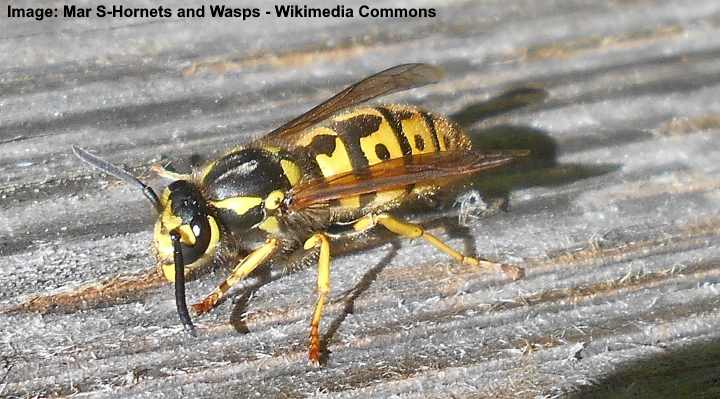
The European wasp is identified by wide yellow bands and narrow black stripes and dots on its abdomen
The European wasp is a small black and yellow wasp with a mostly black head and thorax. Identifying features of this wasp are its wide yellow bands and black dots on its abdomen. Additionally, the black head and thorax have yellow markings on the side. This species also has yellow legs.
Also called the German wasp or German yellowjacket, the stinging flying insect measures 0.5” (13 mm) long. The yellowjacket builds nests in gray or brownish, papery structures like paper wasps. A distinguishing feature of this black and yellow wasp is facial markings consisting of three dots between its two compound eyes.
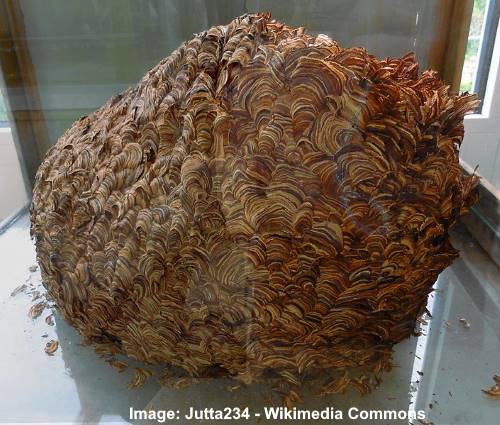
Vespula germanica nest
It can be difficult to tell this species apart from the common European wasp (Vespula vulgaris). However, the European wasp doesn’t have the three dots on its face.
Black and yellow wasp identification
The European wasp has a mostly yellow abdomen with thin black stripes and two dots on three of its abdominal segments.
Common Wasp (Vespula vulgaris)
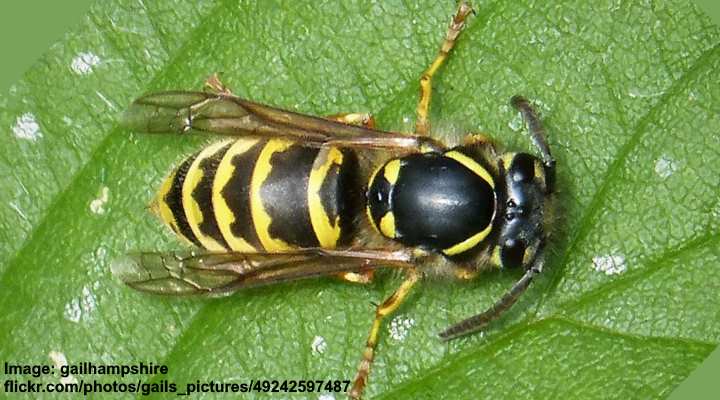
The common wasp is similar to the common yellowjacket (Vespula alascensis) but its nest is above ground and not underground like the common yellowjacket
The common wasp is a stinging insect typically found in Europe rather than North America which looks like the common yellowjacket. Therefore, it is easy to confuse this species with the common yellowjacket (Vespula alascensis). The worker bees have a black and yellow banded abdomen, black thorax with yellow markings on the base and sides, and a stout, black head.
The common wasp measures 0.5” to 0.7” (13 – 17 mm) long. Like the European wasp, it has black bands and dots on its abdominal section. The black spots sometimes merge with the black bands. It also has an identifiable black stripe on the front of its yellow face. The social wasps live in large tan papery nests.
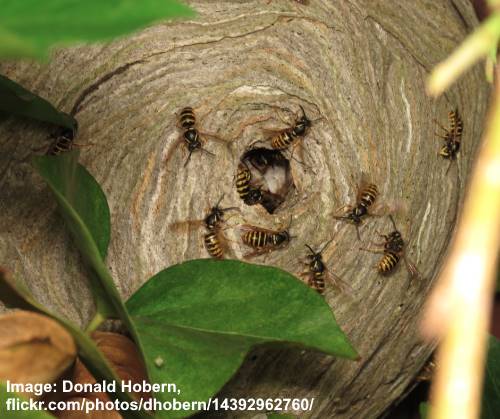
Vespula vulgaris nest
Black and yellow wasp identification
The identifying features of the common wasp are its black and yellow bands around its abdomen, yellow and brown legs, and brown transparent wings.
Western Yellowjacket (Vespula pensylvanica)
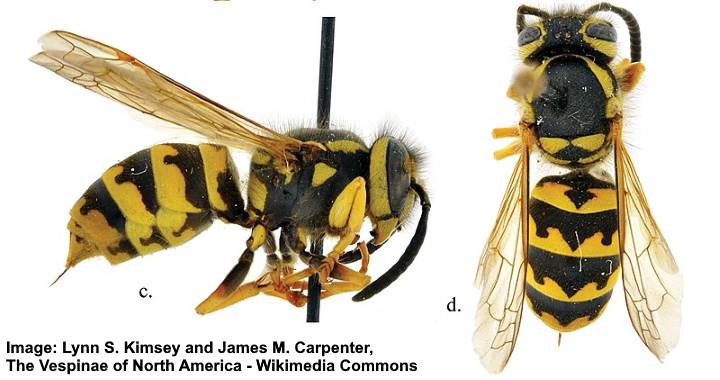
The black and yellow striped western yellowjackets have yellow ring around their eyes, distinct black diamond shape on its abdomen and are ground nesting insects
The western yellowjacket is a native North American black and yellow wasp which looks similar to other species of yellowjackets. This stinging wasp is typically only found in the western half of North America. It has black and yellow striped patterns traversing its pear-shaped abdomen.
The Western yellowjackets are ground-burrowing black and yellow wasps. The flying insects measure 0.6” (15 mm) long. A distinguishing feature of this wasp is the yellow eye ring around each compound eye. Additionally, it has a distinct black diamond shape on its abdominal segment closest to the waist.
Black and yellow wasp identification
The easily identifiable feature of the western yellowjacket is the small black triangular just below its waist. It also has two yellow rings around each eye.

Vespula pensylvanica nests are in the ground
Prairie Yellowjacket (Vespula atropilosa)
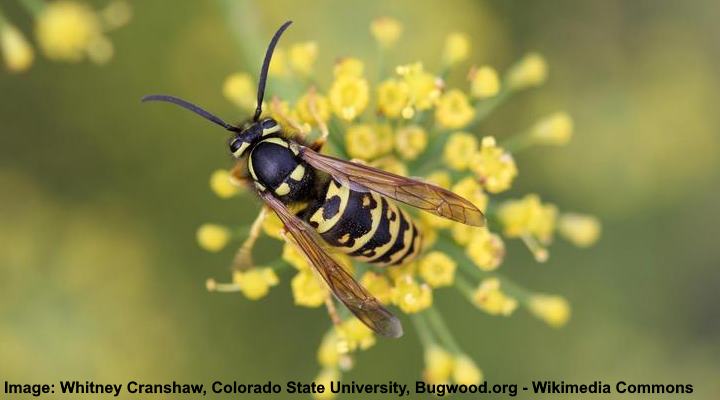
The black and yellow prairie yellowjacket have black bands with yellow spots on the abdomen and is common in western U.S. and the Midwest
The prairie yellowjacket is a black and yellow wasp with thick black bands and yellow dots on its abdominal section. Like many species of yellowjackets, the first abdominal segment has different patterns than the others. This species has a black oval mark and two spots.
The prairie yellowjacket measures 0.4” to 0.6” (10 – 15 mm) long. The black and yellow wasp is common in the western United States and the Midwest. Depending on the area, some wasps have more black than yellow colors, whereas others are more yellow than black.
Like all species of yellowjackets, this species feeds on small bugs, insects, and spiders.
As its name suggests, this yellow and black wasp species prefers living in open grasslands and parks. It has a similar distribution range to the Western yellowjacket (Vespula pensylvanica).
Black and yellow wasp identification
The prairie yellowjacket is identified by its back thorax with two yellow spots and bands around the sides. It also has broad black bands on its abdomen, some of which have yellow spots.
European Hornet (Vespa crabro)
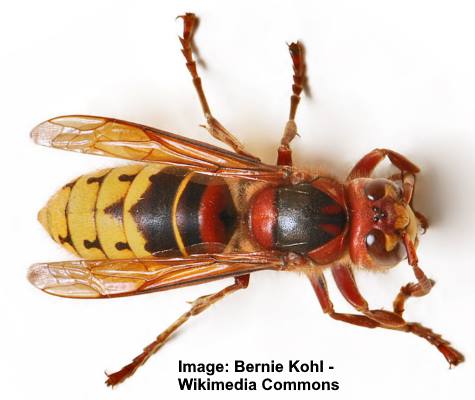
The large European hornet has black and red thorax and its abdomen is black and yellow
The European hornet is one of the largest wasps in North America. Its distinguishing characteristics include its bright yellow abdomen with two blackish-brown bands and several dots. Additionally, this large wasp has a reddish head, thorax, and first abdominal section. It also has characteristic C-shaped reddish-brown eyes.
The typical European hornet grows about 1” (25 mm) long. Due to its large size and aggressive behavior, the wasp can be a nuisance during summer when it is most active. However, European hornets only tend to show aggressiveness when provoked.
European hornets create paper nests that are irregular in shape. Although native to Europe, this hornet species is widespread throughout North America. However, unlike the Asian giant hornet, the species is not considered invasive.
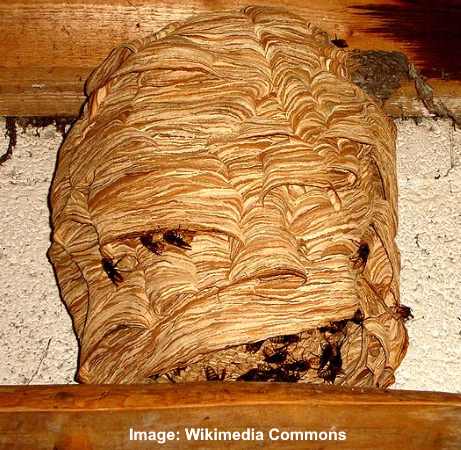
Vespa crabro nest
Black and yellow wasp identification
The European hornet is a large wasp with a yellow abdomen, two dark brown or black abdominal bands, and a reddish-brown thorax and head. In addition, it has red legs, red antennae, and reddish-brown eyes.
Asian Giant Hornet (Vespa mandarinia)
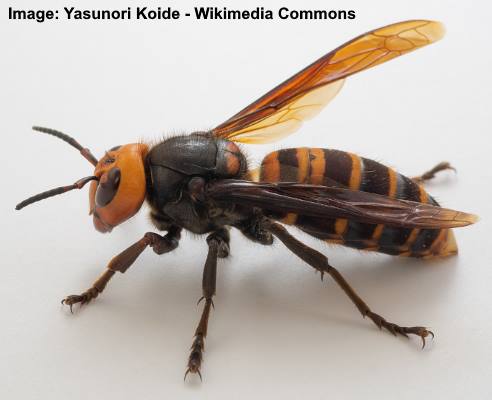
The huge Asian giant hornet has characteristic orange head, mainly black thorax and black and orange-yellow striped abdomen
The Asian giant hornet is a huge aggressive wasp with black and orange-yellow markings. This invasive wasp is identified by its dark brown antennae, black eyes on an orange head, and rounded dark brown or black thorax. The enormous wasps create nests in ground tunnels.
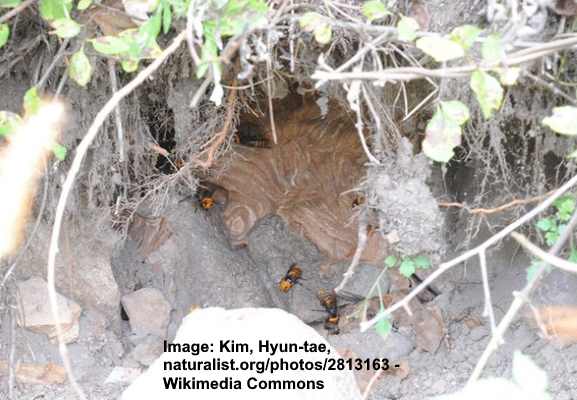
Vespa mandarinia nest
Asian giant hornet grows 1.4” to 3” (35 – 75 mm) long. Although it has the common name Asian giant hornet, it is also commonly called the “murder hornet.” This refers to its invasive habit and aggressiveness toward native honeybees. The huge wasp also feeds on soft fruits, nectar, and honey.
Black and yellow wasp identification
Due to its huge size and brown and yellowish-orange colors, the Asian giant hornet is easily identifiable.
European Paper Wasp (Polistes dominula)

The European paper wasp has a slender black and yellow striped body with orange antennae and yellow-orange legs
The European paper wasp is black with yellow wavy stripes across its tear-shaped abdomen. The black and yellow slender wasp also has an oval black thorax with two yellow markings on each segment. In addition, this wasp has orange antennae and pale yellowish-orange legs.
The European paper wasp measures 0.78” to 2” (20 – 25 mm) long. It is characterized by its smooth, slender body and pale yellowish bands on its abdomen. Its coloration makes this species of paper wasp look like the German yellowjacket (Vespula germanica).
Paper wasps get their name from the paper-like nest they construct. These papery structures look like several hexagonal tubes stuck together.
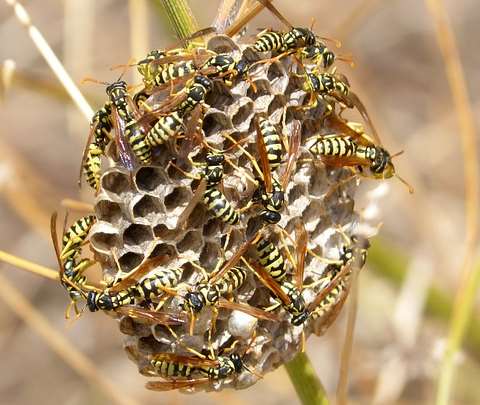
Paper wasp nest
Black and yellow wasp identification
The European paper wasp is a common black wasp with yellow bands traversing its abdomen and two rows of small yellow dots on its black thorax.
Yellow-Legged Mud Dauber Wasp (Sceliphron caementarium)
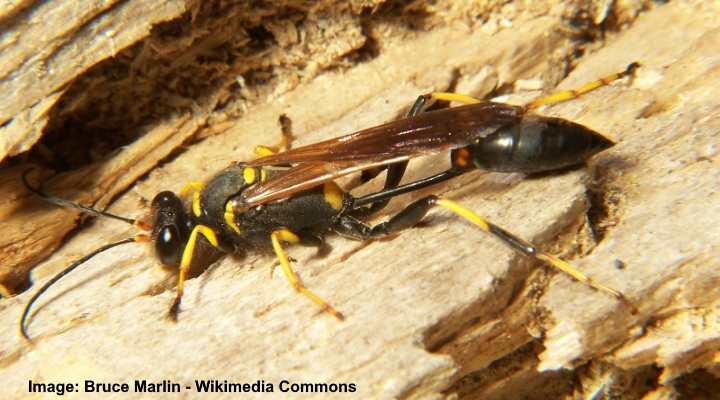
The black-and-yellow mud dauber wasp can be easily identified by its very slim waist
The yellow-legged mud dauber is an easily recognizable black and yellow wasp due to its long, slender waist. Depending on the climate, the long petiole waist can be black or yellow. Other identifying features are its yellow marking on the black thorax, black antennae, and yellow legs.
Also called the black-and-yellow mud dauber, this unusual wasp measures 0.9” to 1.1” (24 – 28 mm) long.
Black and yellow mud daubers are solitary wasps that feed on the larvae of small insects and nectar. Their common name comes from their habit of creating nests from mud containing 25 cylindrical tubes. First, the female lays eggs in the nests and leaves food. Then larvae hatch, and the immature wasps begin feeding.

Sceliphron caementarium nest
Black and yellow wasp identification
The black-and-yellow mud dauber is easy to identify due to the long black (sometimes yellow) petiole connecting the thorax to the abdomen.
Black and Yellow Potter Wasps (Eumenidae)
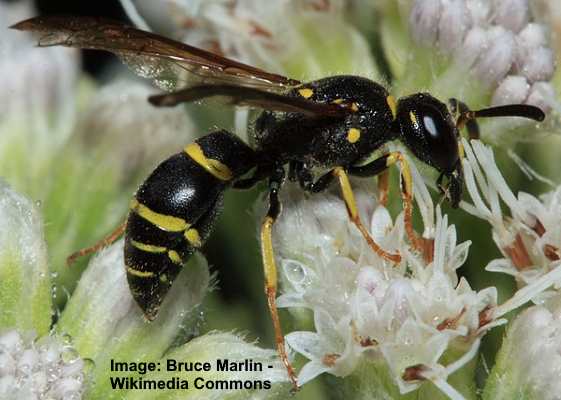
Potter wasps have a black slender body with thin yellow bands and are also called mason wasps
Potter wasps are a type of jet-black wasp with several yellow bands across their abdomen. Other features of these yellow-banded black wasps are the yellow dots on the thorax, black head, and two thick black antennae. Additionally, the wasps have black and yellow legs.
Also called mason wasps, these black and yellow wasps typically measure 0.39” to 0.78” (10 – 20 mm) long. The unusual wasps get their name from the jar-like nest they create out of mud. Depending on the species of potter wasp, the small wasps can have varying degrees of yellow and black coloration.
Black and yellow wasp identification
Mason wasps are identified by their black smooth body with several yellow bands around their abdomen. The pottery nests are another way to identify the presence of potter wasps.
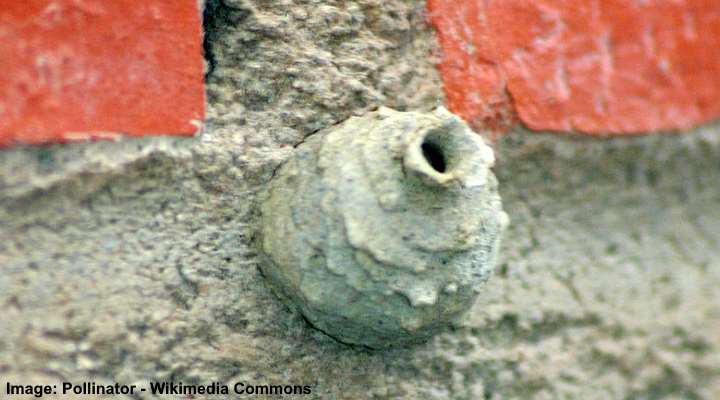
Potter wasp nest
Cicada Killer Wasp (Sphecius speciosus)
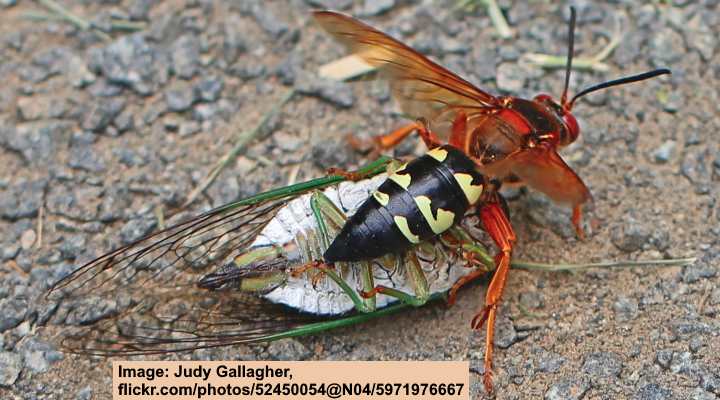
A picture of Eastern cicada killer (Sphecius speciosus) with a cicada
The cicada killer is a large black wasp with three bright pale yellow broken bands across its abdomen. These unique wasps have identifying features, including reddish wings, red legs, and large red compound eyes. Additionally, the enormous black and yellow wasps have two long antennae.
Also called the sand hornet or cicada hawk, this predatory wasp grows around 1.4” (35 mm) long. This makes the large flying insect easy to confuse for a European hornet.
Cicada killers have the habit of creating nests by burrowing in the ground. In some cases, extensive wasp burrowing can destroy lawns or cause patio paving to become uneven.
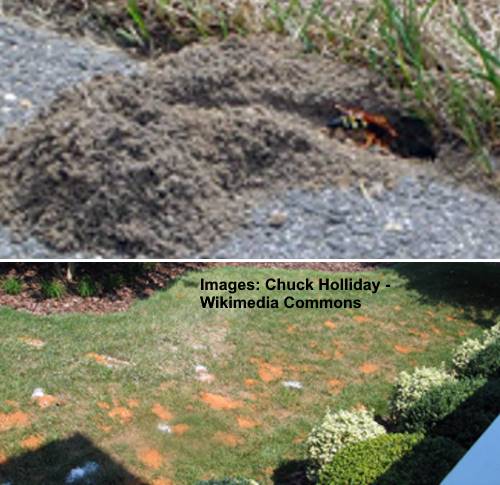
Top image: A female cicada killer wasp digging a burrow next to a driveway. Bottom image: Cicada killer infestation in a yard; the reddish brown patches are cicada killer burrows
Black and yellow wasp identification
The cicada killer wasp looks like a large hornet with a black body, yellow abdominal stripes, and reddish wings.
Saxon Wasp (Dolichovespula saxonica)
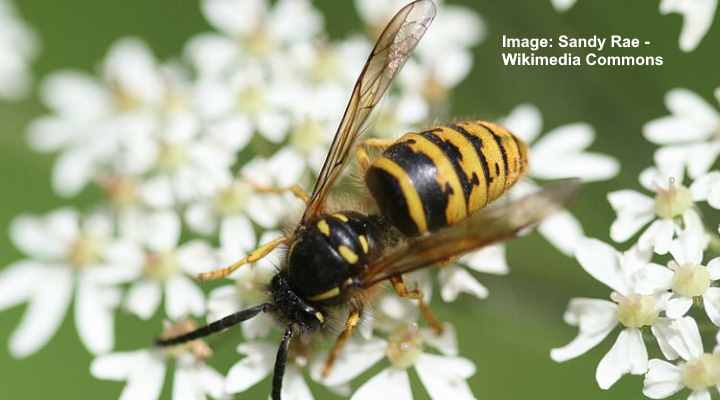
The Saxon wasp is very similar to yellowjackets
The Saxon wasp is a small yellow and black flying insect with a typically striped abdomen. Identifying features of the wasp are the yellow spots on a black thorax, yellow legs, and black antennae. These characteristics make the Saxon wasp look like a small yellowjacket.
Saxon wasps grow 0.42” to 0.59” (11 – 15 mm) long. You can tell this yellow and black wasp apart from the common yellowjacket because of its characteristic long face rather than a short, rounded face. Another distinguishing feature is the three dots on its black head.
Wasps in the genus Dolichovespula are also called yellowjackets colloquially.
Black and yellow wasp identification
The Saxon wasp is identified by its black and yellow striped body, black antennae, and orange legs.

Saxon wasp nest
Tree Wasp (Dolichovespula sylvestris)
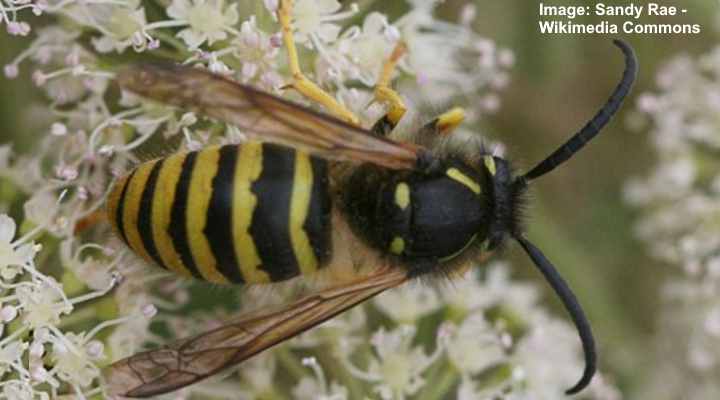
The tree wasp has a black and yellow bands on its abdomen and builds nests on trees and on the ground
The tree wasp is a medium-sized fuzzy wasp with characteristic black and yellow stripes on its abdomen, yellow legs, and a black head and thorax with two yellow dots. Additionally, the wasp has curved black antennae, yellow legs, and brownish wings. This non-aggressive wasp is related to yellowjacket wasps.
The tree wasp is native to Europe and Central Asia. The buzzing insect measures 0.42” to 0.59” (11 – 15 mm). As is usual with species of wasps, the queen wasps are larger, and the female tree wasps can grow up to 0.75” (17 mm) long.
Black and yellow wasp identification
The tree wasp is difficult to differentiate between species of yellowjackets and other wasps in the genus Dolichovespula. It has black and yellow bands around its body and two yellow dots on a black thorax.
Common Aerial Yellowjacket (Dolichovespula arenaria)
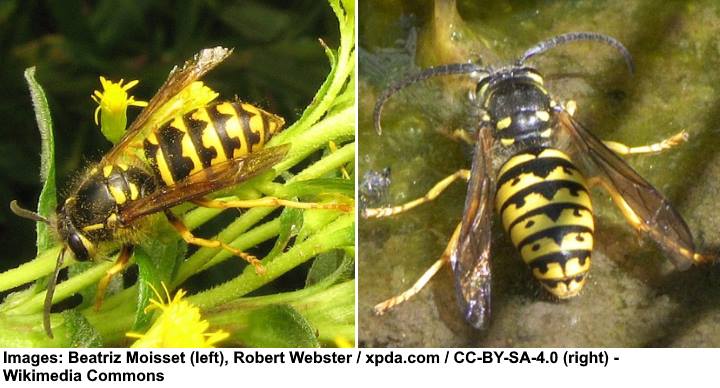
Common aerial yellowjackets can vary in their black and yellow patterns
Also called the sandhills hornet or common yellow hornet, this large black and yellow wasp is common throughout the United States. There are variations in yellow and black patterns among the species. For example, the female aerial yellowjacket has an interrupted yellow line at the base of the abdomen and black spots in the other segments.
However, some wasps lack the spots and have wavy yellow bands across their abdomens. Most species of aerial yellowjackets have four yellow patches on the black thorax and long hooked antennae.
The common aerial yellowjacket measures 0.3” to 0.7” (8 – 18 mm).
Black and yellow wasp identification
The common aerial yellowjacket is identified by its broken black and yellow bands traversing its abdomen.
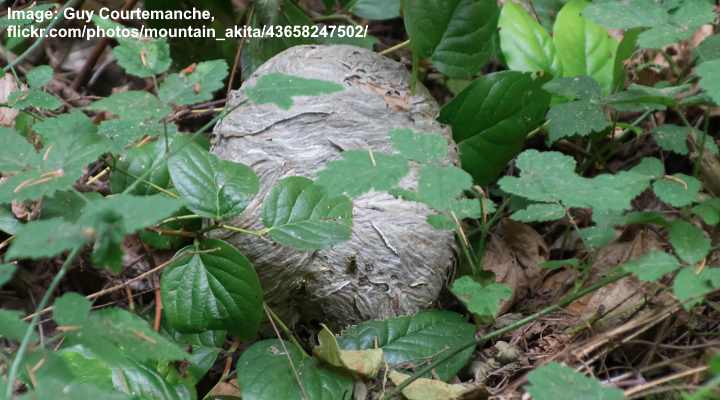
Dolichovespula arenaria nest
Related articles:
